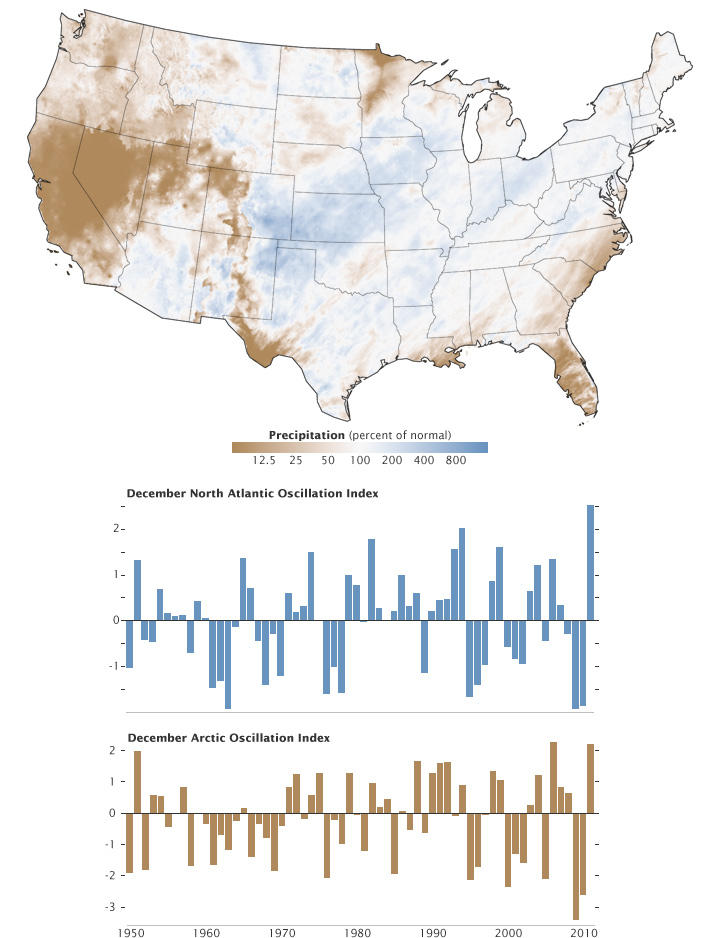


December 2011 was one of the driest Decembers on record in the continental United States—particularly short on snowfall—and also among the warmest. Several large-scale weather and climate patterns are likely to blame for an unusual jet stream and the unseasonal weather.
The top map shows December precipitation across the lower 48 United States as a percentage of normal for the month. The map is based on measurements compiled by the NOAA Advanced Hydrologic Prediction Service. Shades of brown show rain and snow levels below normal, with blues indicating above-average precipitation. Much of the Pacific Coast, the Rockies, and Southeast were extremely dry. Even in areas that were wetter than normal, most precipitation was rain instead of snow.
The middle graph depicts an index of the North Atlantic Oscillation (NAO) for every December since 1950. The lower graph shows an index of the Arctic Oscillation (AO) for the same period. A third piece of the puzzle—La Niña—is shown here.
The North Atlantic Oscillation is the dominant winter weather driver for eastern North America and Europe. The NAO is a ratio of shifting high and low atmospheric pressure. When NAO is strongly positive, atmospheric pressure is higher in the subtropical Atlantic (around the Azores) and lower in the North Atlantic (near Iceland). The result is usually cold and dry weather in northern Canada and Greenland, with warm and wetter weather in the Northeastern U.S.
Likewise, the Arctic Oscillation is a fluctuation of pressure systems around the Arctic Circle. When air pressure near the North Pole is high and the AO is positive, strong winds trap cold air at high latitudes. When the pressure weakens and AO turns negative, cold weather systems leak out of the polar regions and bring blasts of winter to the middle latitudes of North America.
Both the NAO and AO indices were extremely positive in December 2011. (According to blogger and meteorologist Jeff Masters, the NAO actually set a record of +2.52 in December.) The NAO and AO patterns influenced the intensity and track of storm systems, mostly by driving the jet stream northward for most of the month. At the same time, La Niña ocean and atmospheric circulation patterns continued in the Pacific Ocean, pushing the jet stream further away from the continental U.S.
The result was a steady stream of southwesterly winds and very few bursts of Arctic weather descending to mid-latitudes. The more tangible result was a lack of snow around the country, a complete turnaround from last year.
“The Mammoth Mountain ski resort in the Sierras of California got more than 200 inches of snow last December,” said NASA climatologist Bill Patzert of the Jet Propulsion Laboratory. “This December they got less than 10 inches.”
Masters adds: “This winter's remarkable AO/NAO pattern stands in stark contrast to what occurred the previous two winters, when we had the most extreme December jet stream patterns on record in the opposite direction (a strongly negative AO/NAO). The December Arctic Oscillation index has fluctuated wildly over the past six years, with the two most extreme positive and two most extreme negative values on record. Unfortunately, we don't understand why the AO varies so much from winter to winter, nor why the AO has taken on such extreme configurations during four of the past six winters.”
Images by Hunter Allen (NOAA) and Robert Simmon (NASA), based on data from the NOAA Advanced Hydrologic Prediction Service (map) and National Weather Service Climate Prediction Center (graphs). Caption by Mike Carlowicz.